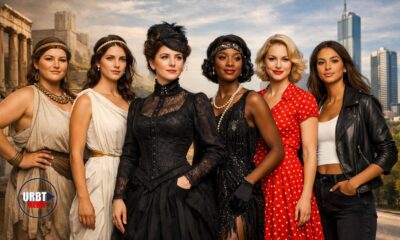Published
4 months agoon
When comedian and internet personality Druski, known for his viral sketches and collaborations with top hip-hop artists, steps into character, the internet listens. His humor often lives at the intersection of exaggeration, satire, and uncomfortable truths about culture. But when Druski dons “white face”—portraying exaggerated versions of suburban white characters—it sparks a mix of laughter, discourse, and questions about where the lines of comedy really lie.
Born Drew Desbordes, Druski has become one of the most recognizable comedic figures of the last five years. With millions of followers across platforms, his short sketches and improv routines lean heavily on relatable archetypes: the over-zealous coach, the shady promoter, the try-hard frat boy. His ability to embody these personas has earned him spots alongside Drake, Jack Harlow, and other music stars. Unlike traditional stand-up comics, Druski thrives in the digital space where memes spread faster than punchlines.
In several of his sketches, Druski puts on makeup, wigs, or simply adopts a manner of speaking to caricature stereotypical white characters. Sometimes he’s a corporate boss out of touch with his employees. Other times he’s a suburban dad who tries a little too hard to use slang. The effect is clear: it flips the well-worn trope of “black face” on its head, allowing a Black comedian to poke fun at white culture through mimicry.
These skits often go viral because they’re both funny and familiar. People recognize the types of characters Druski is mocking—corny authority figures, awkward partygoers, or “cool” white friends who overcompensate when hanging around Black peers.
Comedy has long thrived on caricature. From Saturday Night Live to Key & Peele, performers use wigs, accents, and body language to bring stereotypes to life in ways that are meant to be both entertaining and thought-provoking. Druski’s “white face” performances operate in this tradition, highlighting the absurdities of cultural differences while inviting viewers to laugh at the shared awkwardness of social interactions.
What makes Druski unique is how effortlessly he transitions between these worlds. He can move from portraying a Southern Black uncle to a frat boy from Ohio in the span of a single sketch. This versatility underscores his comedic talent—but it also raises bigger cultural questions.
Whenever “white face” comedy appears, some critics argue it represents a double standard. They ask: if blackface is widely condemned for its racist history, why is it socially acceptable for Black comedians to parody white people in the same exaggerated way?
The counterargument, which many comedians and cultural critics point out, is rooted in history and power dynamics. Blackface in the 19th and early 20th centuries wasn’t just a comedic device; it was a tool of dehumanization that reinforced systemic racism. White performers painted their faces to mock and demean Black people, often reducing them to harmful caricatures that justified discrimination.
By contrast, “white face” lacks that same historical baggage. Instead, it functions more as satire—punching upward at cultural norms of privilege, awkward assimilation, or obliviousness. For many audiences, Druski’s sketches land not as attacks on whiteness itself, but as humorous critiques of behavior patterns recognizable across social settings.
Online reactions to Druski’s “white face” content are mixed, but often lean toward positive. Comment sections fill with viewers saying things like, “Bro nailed this character” or “I know someone just like this.” The relatability of the archetypes allows his audience—regardless of race—to laugh at the awkwardness of cultural misunderstandings.
That said, a subset of viewers push back, arguing that comedy shouldn’t rely on any form of racial caricature. In today’s hyper-aware climate, where conversations about race and representation dominate cultural discourse, even satire can become polarizing.
Comedy has always tested boundaries. From Richard Pryor to Dave Chappelle, some of the most iconic comedians gained prominence by walking the fine line between humor and offense. Druski’s “white face” sketches exist within this lineage, asking audiences to reflect on how cultural behaviors look from the outside.
In many ways, his comedy exposes a shared humanity. By exaggerating certain behaviors, he shows us how ridiculous we all can be when we’re trying too hard—whether it’s fitting into a social circle, acting like an authority, or pretending to understand a culture we’re not part of.
At its core, Druski’s “white face” isn’t about mocking race itself. It’s about highlighting the quirks, contradictions, and sometimes cringe-worthy behaviors that emerge in cross-cultural interactions. Like much of his comedy, it relies on recognition—audiences laugh because they see a bit of truth in the performance.
Whether one views it as harmless satire or problematic caricature depends largely on perspective. But one thing is certain: Druski’s ability to spark both laughter and debate proves he’s more than just an internet comedian. He’s part of a long tradition of humor that pushes culture to confront itself—even if the conversation gets uncomfortable.
Druski white face | Druski controversy | Druski comedy | whiteface debate | satire vs racism | comedian controversy | Druski backlash | offensive comedy | boundaries of comedy | Druski whiteface explanation | Druski’s whiteface routine | racial satire debate | comedy and social commentary | Druski and the debate over “White Face”: Comedy | Satire | or Controversy? | Druski’s whiteface apology | impact of Druski’s whiteface | Druski’s performance analysis | minstrelsy and modern comedy.
Druski #WhiteFace #Comedy #Controversy #Satire #Racism #SocialCommentary #FreeSpeech



Christmas Returns Explode: Americans Return Gifts to Pay Rent, Utilities


Sega Co-Founder David Rosen Dies at 95: Gaming Pioneer’s Legacy


The Shifting Sands of Beauty – A History of the “Ideal” Woman


Young Teens Stumbling Across Porn: How They Find It and What to Do


George Zimmerman’s Job Struggle: A Life Sentence After Acquittal?


African Union Urges Accurate World Maps to Reflect Africa’s True Size